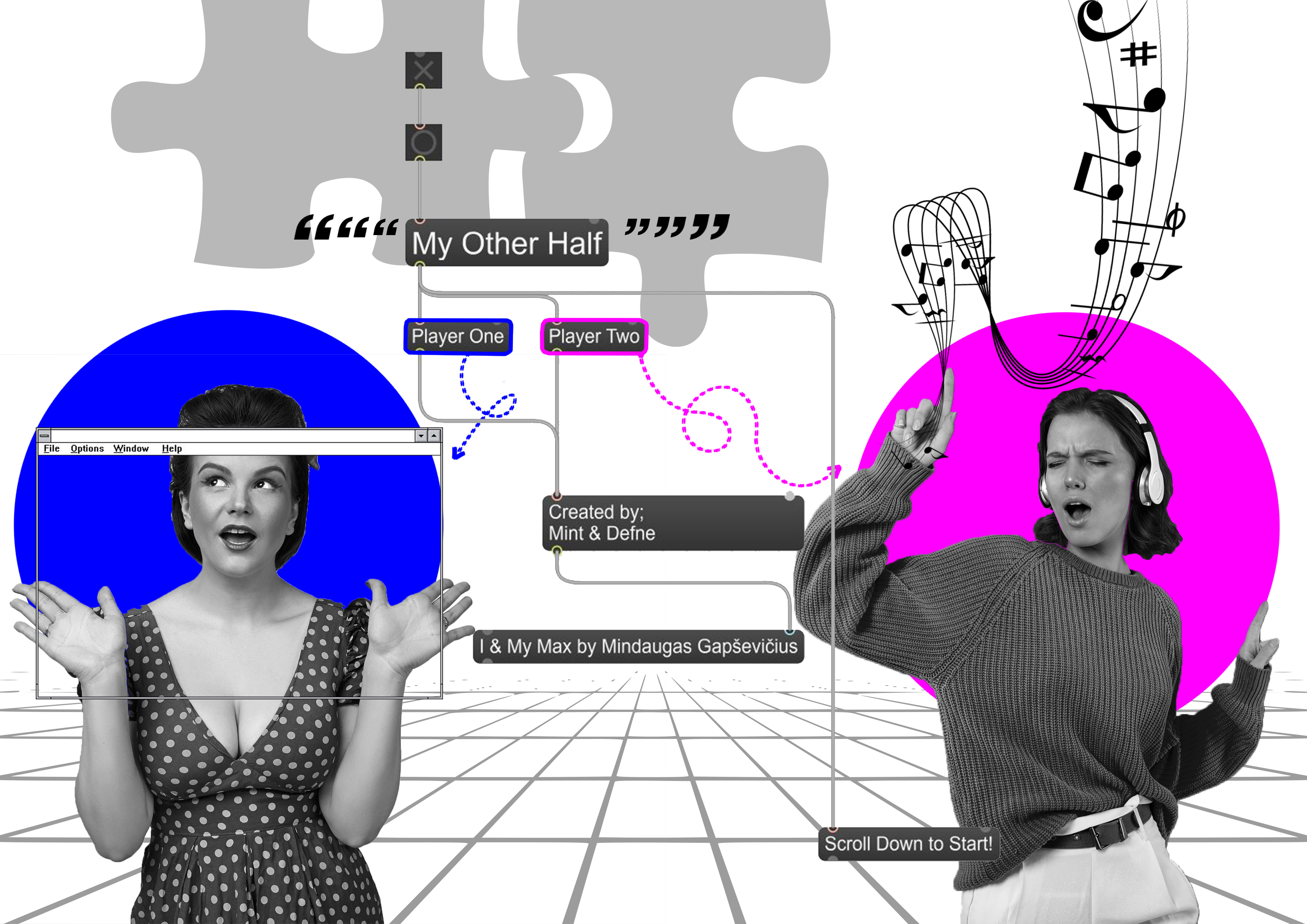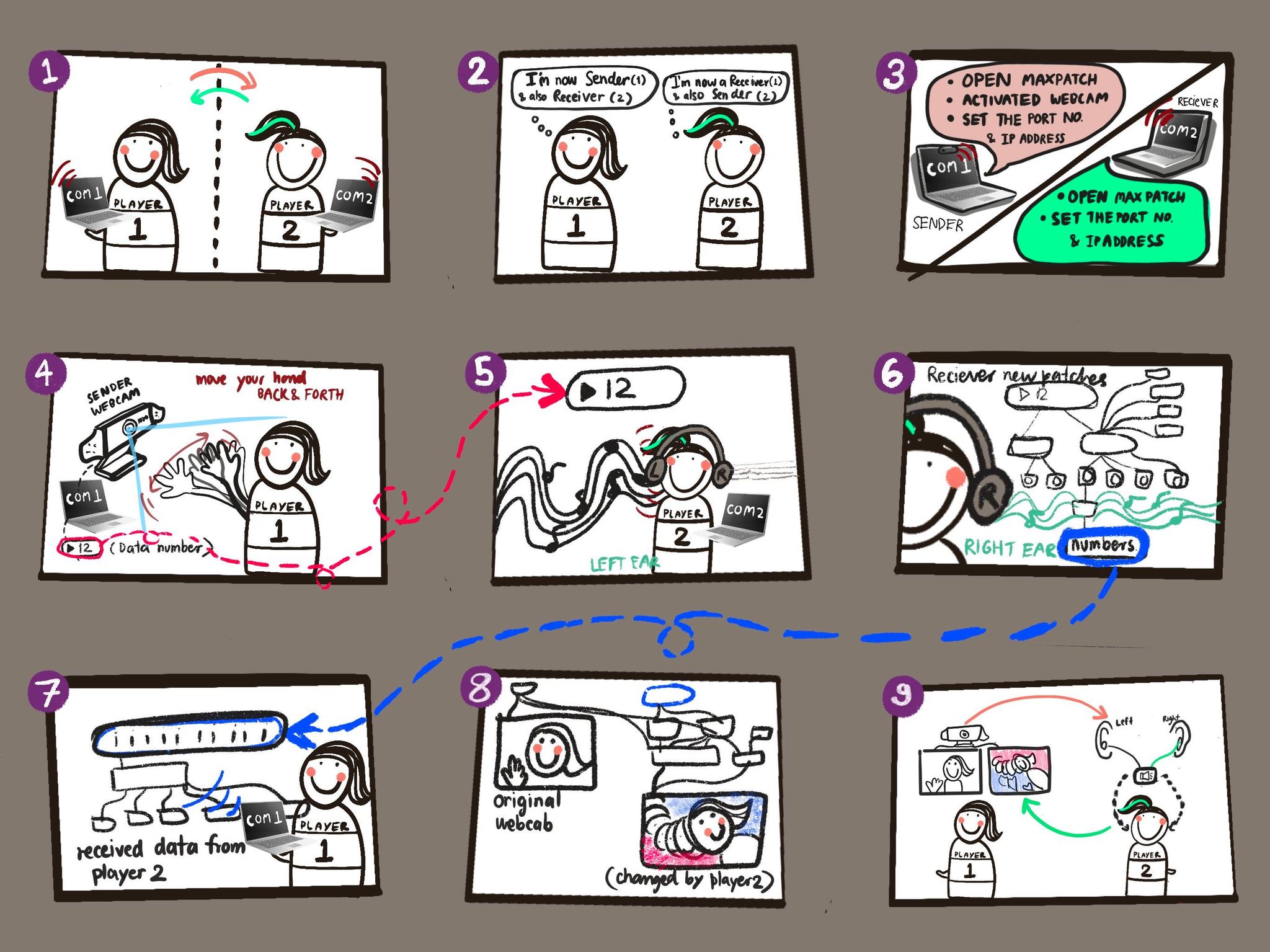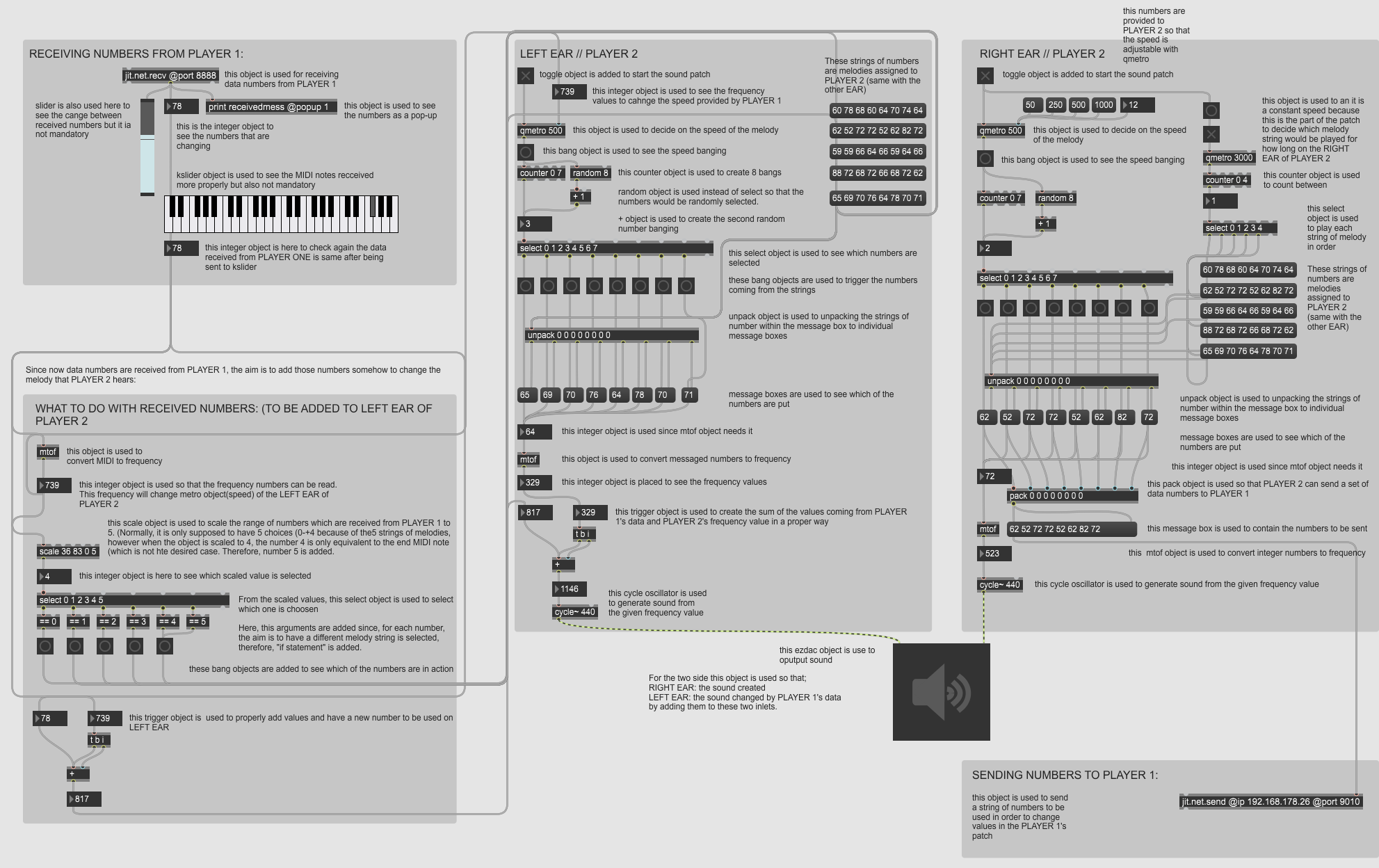Isiklidefne (talk | contribs) |
Isiklidefne (talk | contribs) |
||
| (29 intermediate revisions by 2 users not shown) | |||
| Line 1: | Line 1: | ||
==Semester Project: My Other Half== | |||
[[File:postermax-myotherhalf.jpg]] | |||
This piece is a collaborative work created by Defne Isikli and Chanitnanth Phadungnanonth. “My Other Half” is an interactive semester project for 2 users. This interactive manner of the project results in a game-like situation, that is why they are called players. The project offers a visual experience for Player 1 and auditory experience for Player 2. Players are also able to realize how they change each other’s experience. | |||
Player 1 has 2 window screens in front of her: one with her normal Webcam and the second with her Webcam with effects. These affects are created and constantly changing by the numbers provided Player 2. | |||
Player 2 has Left and Right Headphone icons in front of her and she has her own melody on right ear and the melody on her left ear modified by the number data sent by Player 2. | |||
'''I am only [[Player 2]], so, if you want to learn more go check Chanitnanth Phadungnanonth’s page (https://www.uni-weimar.de/kunst-und-gestaltung/wiki/GMU:I_and_my_Max/Chanitnanth_Phadungnanonth) to find out about Player 1.''' | |||
[[File:instructions-max.jpg]] | |||
INSTRUCTIONS: | |||
Welcome to My Other Half | |||
1- In order to interact, it is required to have 2 players with 2 computers. One player should have a computer with a Webcam and the other should have a headphone. | |||
2- To set the connection between 2 computers, all players should be aware of their IP addresses and should be connected to the Internet through the same WIFI. Since the communication between 2 computers are both ways, each Player has their own “jit.net.send” and “jit.net.recv” objects. Therefore, they are both the sender and the receiver. How to open patch, how to deal with port numbers and how to insert IP address will be explained in the following paragraph: | |||
3- Player 1 should follow the instructions on how to connect her Webcam to the patch. After each Player open their patches, they both should enter each other's IP addresses to their own “jit.net.send” objects and make sure the port numbers are the same. | |||
HINT: Make sure your PC security programs/firewalls are enabling MAX to send and receive messages | |||
4- My Other Half starts with Player 1. She should move her hands facing the Webcam and which will create data numbers. | |||
5- These numbers will be delivered to the patch of Player 2. On the Left Ear of Player 2, the modified melody(the melody modifies within some aspects from the numbers received from Player 1) will be played. | |||
6- Player 2 then needs to open her Right Ear, to her own designed melody. According to the patch of Player 2, some data numbers will be ready to be sent to the patch of Player 1. | |||
7- The received data numbers start to change the Webcam screen of Player 1. | |||
8- Player 1 can see how Player 2 modified her Webcam attributes and how her appearance is changed. (saturation, brightness, contrast, hue angle, theta, gain and speed(qmetro)) | |||
9- My Other Half is now set as an interactive experience. Each player forwards their data consecutively. | |||
ENJOY! | |||
P.S.: Both patches are worked together and the final outcome is a collaborative work of 2 people who had no idea about MAX before this class! | |||
'''To see how our patches working you can check our video:''' | |||
https://www.youtube.com/watch?v=mNh5NgpX4BI | |||
You can also check my patch: | |||
[[:File:myotherhalf-player2.maxpat]] | |||
[[File:PLAYER2-myotherhalf.png]] | |||
==Assignment== | ==Assignment== | ||
[[:File:Untitled1.maxpat]] | [[:File:Untitled1.maxpat]] | ||
| Line 35: | Line 85: | ||
== Assignment 09.12.2020== | == Assignment 09.12.2020== | ||
[[:File:video-webcam.maxpat]] | *[[:File:video-webcam.maxpat]] | ||
[[:File:piano-webcam-music-defneandmint.maxpat]] | *[[:File:piano-webcam-music-defneandmint.maxpat]] | ||
<gallery> | |||
File:Screen Shot 2020-12-16 at 6.28.01 PM.png | |||
File:Screen Shot 2020-12-16 at 6.31.14 PM.png | |||
</gallery> | |||
'''OUR Tutorials link''' | |||
'''Frame Differencing (Motion) to MIDI Sequencer Max MSP tutorial''' | |||
https://www.youtube.com/watch?v=BhgVt3I5ALc&t=834s | |||
'''-Motion Tracking Sound - Kinect, Max and Ableton Live to Create Music From Movement''' | |||
https://www.youtube.com/watch?v=2GoAk79I44Y&list=PLQnPjiU2CsJQnX2rEAwAS_EQRnQWboJaS&index=17&t=56s | |||
'''Drawing sound''' | |||
https://www.youtube.com/watch?v=jHVIAWJmcdc&list=PLQnPjiU2CsJQnX2rEAwAS_EQRnQWboJaS&index=7 | |||
'''another drawing sound''' | |||
https://www.youtube.com/watch?v=BybK9CQFy-w&list=PLQnPjiU2CsJQnX2rEAwAS_EQRnQWboJaS&index=10&t=129s | |||
We find some tutorials about how to use frame difference to create a melody with your movement. So, we tried it out and got the idea for make it a 2 player game: | We find some tutorials about how to use frame difference to create a melody with your movement. So, we tried it out and got the idea for make it a 2 player game: | ||
| Line 48: | Line 122: | ||
The Structure of the Game | The Structure of the Game | ||
Start: | Start: | ||
Round 1: | Round 1: | ||
PLAYER 1: | PLAYER 1: | ||
Movement --> Melody of player 1 --> Melody Stored | Movement --> Melody of player 1 --> Melody Stored | ||
then, PLAYER 2: | then, PLAYER 2: | ||
Movement to make same as Melody 1 --> Melody of Player 2 --> Melody Stored | Movement to make same as Melody 1 --> Melody of Player 2 --> Melody Stored | ||
then, | then, | ||
Melodies will be compared, if they are same/similar (pitch, amplitude or frequency???) --> Play 2 gets 1 point. | Melodies will be compared, if they are same/similar (pitch, amplitude or frequency???) --> Play 2 gets 1 point. | ||
then, | then, | ||
if the melody is not same, no one gets a point. | if the melody is not same, no one gets a point. | ||
Round 2: | Round 2: | ||
The game will be repeated as Round 1 by starting with PLAYER 2. | The game will be repeated as Round 1 by starting with PLAYER 2. | ||
Points are stored until 5 points. | Points are stored until 5 points. | ||
The game ends if one of the players reach 5 Points. | The game ends if one of the players reach 5 Points. | ||
if Player 1: Winner, then Player 2: Loser | if Player 1: Winner, then Player 2: Loser | ||
if Player 2: Winner, then player 1: Loser | if Player 2: Winner, then player 1: Loser | ||
GAME OVER! | GAME OVER! | ||
(maybe we can add rematch button to make it restart) | (maybe we can add rematch button to make it restart) | ||
Latest revision as of 01:20, 3 February 2021
Semester Project: My Other Half
This piece is a collaborative work created by Defne Isikli and Chanitnanth Phadungnanonth. “My Other Half” is an interactive semester project for 2 users. This interactive manner of the project results in a game-like situation, that is why they are called players. The project offers a visual experience for Player 1 and auditory experience for Player 2. Players are also able to realize how they change each other’s experience.
Player 1 has 2 window screens in front of her: one with her normal Webcam and the second with her Webcam with effects. These affects are created and constantly changing by the numbers provided Player 2.
Player 2 has Left and Right Headphone icons in front of her and she has her own melody on right ear and the melody on her left ear modified by the number data sent by Player 2.
I am only Player 2, so, if you want to learn more go check Chanitnanth Phadungnanonth’s page (https://www.uni-weimar.de/kunst-und-gestaltung/wiki/GMU:I_and_my_Max/Chanitnanth_Phadungnanonth) to find out about Player 1.
INSTRUCTIONS:
Welcome to My Other Half
1- In order to interact, it is required to have 2 players with 2 computers. One player should have a computer with a Webcam and the other should have a headphone.
2- To set the connection between 2 computers, all players should be aware of their IP addresses and should be connected to the Internet through the same WIFI. Since the communication between 2 computers are both ways, each Player has their own “jit.net.send” and “jit.net.recv” objects. Therefore, they are both the sender and the receiver. How to open patch, how to deal with port numbers and how to insert IP address will be explained in the following paragraph:
3- Player 1 should follow the instructions on how to connect her Webcam to the patch. After each Player open their patches, they both should enter each other's IP addresses to their own “jit.net.send” objects and make sure the port numbers are the same.
HINT: Make sure your PC security programs/firewalls are enabling MAX to send and receive messages
4- My Other Half starts with Player 1. She should move her hands facing the Webcam and which will create data numbers.
5- These numbers will be delivered to the patch of Player 2. On the Left Ear of Player 2, the modified melody(the melody modifies within some aspects from the numbers received from Player 1) will be played.
6- Player 2 then needs to open her Right Ear, to her own designed melody. According to the patch of Player 2, some data numbers will be ready to be sent to the patch of Player 1.
7- The received data numbers start to change the Webcam screen of Player 1.
8- Player 1 can see how Player 2 modified her Webcam attributes and how her appearance is changed. (saturation, brightness, contrast, hue angle, theta, gain and speed(qmetro))
9- My Other Half is now set as an interactive experience. Each player forwards their data consecutively. ENJOY!
P.S.: Both patches are worked together and the final outcome is a collaborative work of 2 people who had no idea about MAX before this class!
To see how our patches working you can check our video:
https://www.youtube.com/watch?v=mNh5NgpX4BI
You can also check my patch:
Assignment
Artworks and research
The artwork I would like to share:
Vision WALL - An Interactive LED Dance Created an interactive environment for participants to explore using their body as the controller for a fully immersive experience. Using the Xbox Kinect and synapse to receive data from the user, I sent that data to MAX/MSP/JITTER. When your hands and feet reaches a Y coordinate it communicates with two arduinos behind the walls using maxuino to turns on specific LED lights. https://cycling74.com/projects/wall-interactive-led-dance
Extras:
Julien Bayle (artist), Julien Bayle is a multidisciplinary & independent artist based in France, working at the juncture of sound & visual. He merges visual art, music composition and physical approach of sound art by creating advanced programmed installations and audio/visual live performances.
Sound and light installations
His works (using MAX): Max MSP Cloud Structure, FRGMENTS, STRUCTURE.INSTALLATION
http://julienbayle.net/
Sabina Studio / Art & Technology singing dust / jitter Max MSP / shaders https://www.youtube.com/watch?v=et00hhgIKkE
Alessandra Marfisa (artist) using MAX/MSP/Jitter https://vimeo.com/marfisa
I also started watching some videos from Amazing Max Stuff as Mojjo mentioned in the previous class. https://www.youtube.com/channel/UCvDUaH2fbXP_Yc5Lc9UXfqA
Kit Clayton, San Francisco-based electronic and digital musician and computer programmer. He is a developer at San Francisco software company Cycling '74, helping create the Max/MSP MIDI/audio programming environment. http://www.musork.com/index.html
Assignment 09.12.2020
OUR Tutorials link
Frame Differencing (Motion) to MIDI Sequencer Max MSP tutorial
https://www.youtube.com/watch?v=BhgVt3I5ALc&t=834s
-Motion Tracking Sound - Kinect, Max and Ableton Live to Create Music From Movement
https://www.youtube.com/watch?v=2GoAk79I44Y&list=PLQnPjiU2CsJQnX2rEAwAS_EQRnQWboJaS&index=17&t=56s
Drawing sound
https://www.youtube.com/watch?v=jHVIAWJmcdc&list=PLQnPjiU2CsJQnX2rEAwAS_EQRnQWboJaS&index=7
another drawing sound
https://www.youtube.com/watch?v=BybK9CQFy-w&list=PLQnPjiU2CsJQnX2rEAwAS_EQRnQWboJaS&index=10&t=129s
We find some tutorials about how to use frame difference to create a melody with your movement. So, we tried it out and got the idea for make it a 2 player game:
We (Me and Mint) thought about making a game with two players: The game will start when Player 1 makes some movement and through webcam, he/she creates a melody. When it is recorded, Player 2 tries to make the same melody by making the similar movements (not necesarrily the same movements as well). The game evaluates the melodies to each other, if they are similar, Player 2 wins a point. First one to reach 10 points wins!
The Structure of the Game Start:
Round 1:
PLAYER 1:
Movement --> Melody of player 1 --> Melody Stored
then, PLAYER 2:
Movement to make same as Melody 1 --> Melody of Player 2 --> Melody Stored
then,
Melodies will be compared, if they are same/similar (pitch, amplitude or frequency???) --> Play 2 gets 1 point.
then,
if the melody is not same, no one gets a point.
Round 2:
The game will be repeated as Round 1 by starting with PLAYER 2.
Points are stored until 5 points.
The game ends if one of the players reach 5 Points.
if Player 1: Winner, then Player 2: Loser
if Player 2: Winner, then player 1: Loser
GAME OVER!
(maybe we can add rematch button to make it restart)




